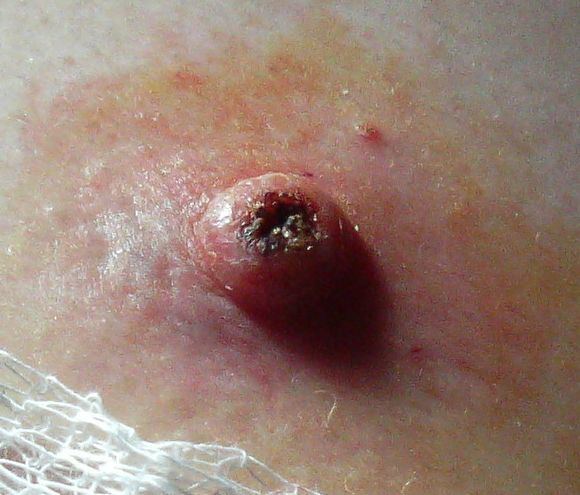Specialty oncology, dermatology DiseasesDB 29383 Patient UK Keratoacanthoma | ICD-9-CM 238.2 eMedicine derm/206 | |
 | ||
ICD-10 D23 (ILDS D23.L71) (ICD10.v4 L85.8) | ||
Keratoacanthoma (KA) is a common low-grade (unlikely to metastasize or invade) skin tumour that is believed to originate from the neck of the hair follicle.
Contents
The defining characteristic of KA is that it is dome-shaped, symmetrical, surrounded by a smooth wall of inflamed skin, and capped with keratin scales and debris. It grows rapidly, reaching a large size within days or weeks, and if untreated for months will almost always starve itself of nourishment, necrose (die), slough, and heal with scarring. KA is commonly found on sun-exposed skin, often face, forearms and hands.
Under the microscope, keratoacanthoma very closely resembles squamous cell carcinoma. In order to differentiate between the two, almost the entire structure needs to be removed and examined. While some pathologists classify KA as a distinct entity and not a malignancy, about 6% of clinical and histological keratoacanthomas do progress to invasive and aggressive squamous cell cancers; some pathologists may label KA as "well-differentiated squamous cell carcinoma, keratoacanthoma variant", and prompt definitive surgery may be recommended.
Classification
Keratoacanthomas (molluscum sebaceum) may be divided into the following types:
Cause
Keratoacanthoma usually occurs in older individuals. As with squamous cell cancer, it seems likely that ultraviolet light from the sun causes the development of KA. As with squamous cell cancer, sporadic cases have been found co-infected with the human papilloma virus (HPV).
Many new treatments for Melanoma are also known to increase the rate of Keratoacanthoma, such as the B-Raf inhibitor drugs Vemurafenib and Dabrafenib.
Diagnosis
Keratoacanthoma presents as a fleshy, elevated and nodular lesion with an irregular crater shape and a characteristic central hyperkeratotic core. Usually the patient will notice a rapidly growing dome-shaped tumor on sun-exposed skin.
If the entire lesion is removed, the pathologist will probably be able to differentiate between keratoacanthoma and squamous cell carcinoma. If only part of the lesion is removed, confident diagnosis may be impossible.
Treatment
Excision of the entire lesion, with adequate margin, will remove the lesion, allow full tissue diagnosis, and leave a planned surgical wound which can usually be repaired with a good cosmetic result. However, removing the entire lesion (especially on the face) may present difficult problems of plastic reconstruction. (On the nose and face, Mohs surgery may allow for good margin control with minimal tissue removal, but many insurance companies require the definitive diagnosis of a malignancy before they are prepared to pay the extra costs of Mohs surgery.) Especially in more cosmetically-sensitive areas, and where the clinical diagnosis is reasonably certain, alternatives to surgery may include no treatment (awaiting spontaneous resolution).
On the trunk, arms, and legs, electrodesiccation and curettage often suffice to control keratoacanthomas until they regress. Other modalities of treatment include cryosurgery and radiotherapy; intralesional injection of methotrexate or of 5-fluorouracil have also been used.
Recurrence after electrodesiccation and curettage can occur; it can usually be identified and treated promptly with either further curettage or surgical excision.
